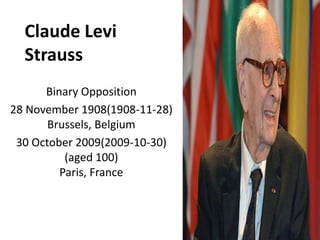
Claude levi strauss[1]
- 1. Claude Levi Strauss Binary Opposition 28 November 1908(1908-11-28)Brussels, Belgium 30 October 2009(2009-10-30) (aged 100)Paris, France
- 2. Levi-Strauss approach to narrative Claude Levi Strauss studied hundreds of myths and legends all around the world, from that he found out that we as humans make sense of the world, people and events by seeing and using binary opposites. He found out that narratives are arranged around the conflict of binary opposites.
- 3. Binary Opposites In the mid-20th century, two major European academic thinkers, Claude Levi Strauss and Roland Barthes, came together and discovered that the way we understand certain words does not depend so much on the meaning that they directly contain, but much more by our understanding of the difference between the word and its 'opposite' or, as they called it 'binary opposite'. They realised that words simply act as symbols for society's ideas and that the meaning of words was a relationship rather than a fixed thing just a relationship between opposing ideas.
- 4. Examples of Binary Opposites Good vs Evil, Black vs White, Boy vs Girl, Peace vs War, Civilised vs Savage, Democracy vs Dictatorship, First world vs Third world, Domestic vs foreign/alien, Articulate vs inarticulate , Young vs Old, Man vs Nature, Protagonist vsantagonist, Action vs inaction, Motivator vs observer, Empowered vs victim , Man vs Woman, Good looking vs Ugly, Strong vs weak, Decisive vs indecisive, East vs West, Humanity vs technology, Ignorance vs wisdom
- 5. Claude Levi Strauss Narrative Theory Summary Basically Levi Strauss theory is that the conflict is based around the binary opposites and that the binary opposites are the central climax of a narrative structure.
- 6. Vladimir Propp’s Theory 17 April 1895St. Petersburg, Russian Empire August 22, 1970(1970-08-22) (aged 75)Leningrad, USSR Literary critic, scholar Russian Folk tales, structuralism
- 7. Propp’s Theory Studied hundreds of fairy tales before deciding that all narratives have the same structure. Observed that narratives are structured by certain types of characters and specific actions. Believes there are 31 different types of stages or functions in any narrative. A tale may skip functions but will not their unvarying order. He believes that there are eight roles in every narrative structure.
- 8. The 8 Roles The Villain- struggles with the hero The Donor- prepares and/or provides the hero with magical agents The Helper- assists, rescues, solves and/or transfigures the hero The Princess- a sought for person, who exist as goal and often recognises and marries the hero and/or punishes the villain The Father- the Princess Guardian The Hero- Departs on a search, reacts to Donor and weds at the end The False Hero- Claims to be Hero, often Seeking to be the Real hero